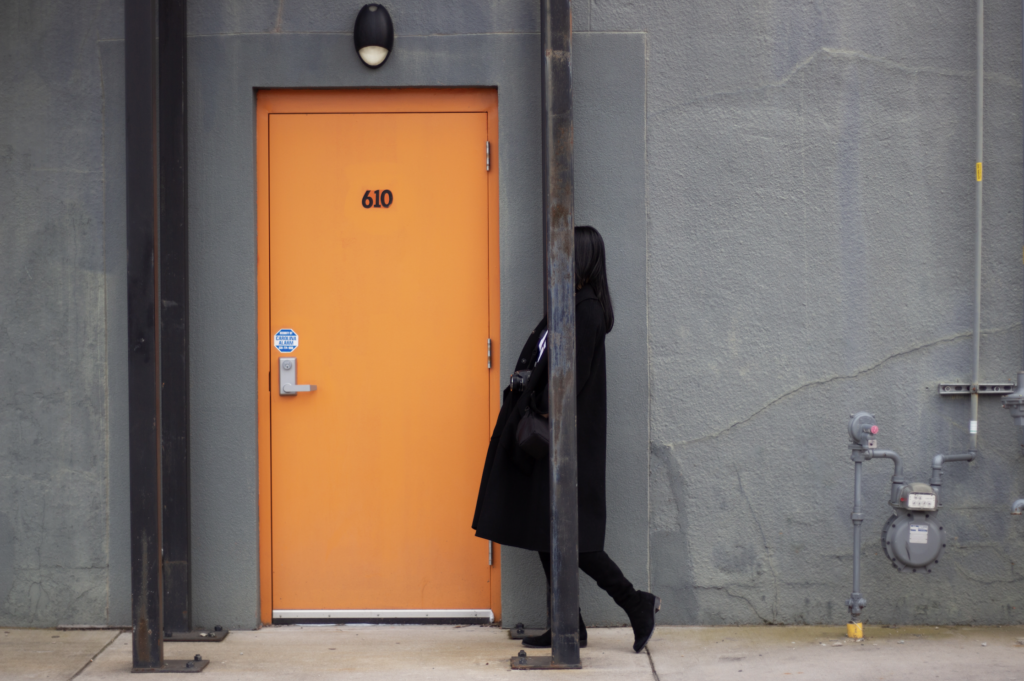Kayla Amador

Kayla Amador
Obscura
APRIL 18 – MAY 20, 2019
MEZZANINE GALLERY
Obscura consists of digital photographs taken in various urban spaces, as an exploration of the interplay between the photographically revealed elements of light, shadow, color, and texture, with a shadow-like figure reappearing throughout these spaces. The silhouette interweaves with features of the scene and becomes a part of the ambiguous or flattened image-space, drawing attention to the relationship between the figure and depicted space. Light and shadow create this tension between architecture and figure, as the figure casts its shadow upon the architecture, and through its presence disrupts that space. In this way, these images draw on the structure of 20th century photography, and may seem to hint at the psychological tension in the tropes of film noir – yet in this case the photographs are performed, composed and shot in broad daylight, contrasting the darkness of the shadow/figure with the spectrum of bright and muted colors of the urban and industrial spaces.
Although the shadow/figure is as paradoxically present as any other element in these compositions, its ambiguity is sometimes increased by my emphasis on the dark form’s shadow itself. In his essay on Japanese aesthetics, Tanizaki Jun’ichirō makes a case for the traditional Eastern preference for the soft depth and subtlety of shadows over the harsh brightness of direct light. Titled In Praise of Shadows, I drew from this essay in photographing for this exhibition, and considered how a human form can appear as a shadow and what it would mean for such a shadow to “exist.”
A shadow is the evidence of impeded light. In contrast to Eastern concepts, shadows tend to have negative associations in the West. These connotations have taken on a moralistic quality over time; with colloquialisms regarding “shedding light,” “illuminating,” “elucidating” as revealing truths and dispelling the “darkness” of evil and ignorance. Non-Western implications of light and shadow became more important to this work as I created it, becoming more apparent as I neared the end of the shooting process and began making selections for the exhibition that would function as a coherent series.
Tanizaki’s essay refers to the aesthetics of Wabi-sabi, developed during the Medieval period of Japan under the influence of Zen Buddhism, wherein nothing is meant to last, and beauty is found in fleeting moments. Emulated in aspects of my images are such features of Wabi-sabi; muted colors and understatement, and an affinity for shadows and supposed “imperfections,” versus the overly bright and extravagant.
A shadow is evidence of a presence, a space not wholly without light but within which we are less able to discern some features. We are left primarily with a shape, or a silhouette. My intention in constructing these images – staging the figure to emulate a traveling shadow – is to create a presence for the shadow/figure, to make it an actor in these spaces of equal importance to the more chromatic elements, as to not have its dark presence visually discarded. A shadow does not simply blend into its surroundings. Rather, it interacts with the space, shaping forms and muting textures, projecting its own shape and texture.
Artist Bio
Kayla Amador is a Senior Japanese Language & Culture and Studio Art Double-Major. Primarily studying Video Art and Photography, in her work she has used these mediums to investigate her interests in the field of Japanese cultural studies, combined with her own personal experiences as a multiracial woman of color.
During her time at Wake Forest University, Amador has been involved in the arts as a member of the 2016-2017 Student Union Art Acquisition Committee and as a student assistant for four years at the Hanes Gallery. She has exhibited in the annual WFU Student Art Exhibition in 2016 and 2017, each time receiving a Wake Forest University Student Art Purchase Award for her works in Video Art. In 2018, she exhibited her photography in a solo exhibition, Kansatsu, at WFU’s START Gallery in Reynolda Village. That same year, she was also the student curator for START.dt’s Deep Dive exhibition.
Following her graduation in May 2019, she will return to Wake Forest University as the next START Gallery Manager.
Reception
Thursday, April 18 6-7:30pm

